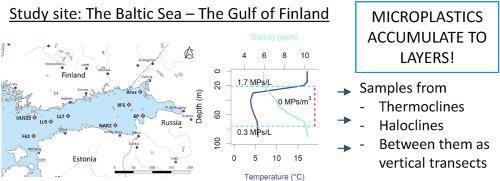Environmental Pollution ( IF 8.9 ) Pub Date : 2020-09-23 , DOI: 10.1016/j.envpol.2020.115700 Emilia Uurasjärvi , Minna Pääkkönen , Outi Setälä , Arto Koistinen , Maiju Lehtiniemi

|
In the Baltic Sea, water is stratified due to differences in density and salinity. The stratification prevents water from mixing, which could affect sinking rates of microplastics in the sea. We studied the accumulation of microplastics to halocline and thermocline. We sampled water with a 100 μm plankton net from vertical transects between halo- and thermocline, and a 30 L water sampler from the end of halocline and the beginning of thermocline. Thereafter, microplastics in the whole sample volumes were analyzed with imaging Fourier transform infrared spectroscopy (FTIR). The plankton net results showed that water column between halo- and thermoclines contained on average 0.92 ± 0.61 MPs m-3 (237 ± 277 ng/m-3; mean ± SD), whereas the 30 L samples from the end of halocline and the beginning of thermocline contained 0.44 ± 0.52 MPs L-1 (106 ± 209 ng L-1). Hence, microplastics are likely to accumulate to thin layers in the halocline and thermocline. The vast majority of the found microplastics were polyethylene, polypropylene and polyethylene terephthalate, which are common plastic types. We did not observe any trend between the density of microplastics and the sampling depth, probably because biofilm formation affected the sinking rates of the particles. Our results indicate the need to sample deeper water layers in addition to surface waters at least in the stratified water bodies to obtain a comprehensive overview of the abundance of microplastics in the aquatic environment.
中文翻译:

微塑料在分层波罗的海中积聚成薄层
在波罗的海,由于密度和盐度的差异,水被分层。分层会阻止水混合,这可能会影响微塑料在海中的下沉速度。我们研究了微塑料向盐环和温跃线的积累。我们从卤化物和温跃层之间的垂直样条上用100μm浮游生物网采样了水,并从卤代碱末端和温跃层开始处采样了30升水。此后,使用成像傅里叶变换红外光谱(FTIR)分析整个样品体积中的微塑料。浮游生物的净结果表明,卤化和热跃线之间的水柱平均包含0.92±0.61 MPs m -3(237±277 ng / m -3; 平均值±SD),而从盐环末端和温跃线开始的30 L样品中含有0.44±0.52 MPs L -1(106±209 ng L -1)。因此,微塑料可能会在盐环和温跃线中积聚成薄层。发现的绝大多数微塑料是聚乙烯,聚丙烯和聚对苯二甲酸乙二醇酯,它们是常见的塑料类型。我们没有观察到微塑料的密度和采样深度之间的任何趋势,可能是因为生物膜的形成影响了颗粒的沉降率。我们的结果表明,除了地表水以外,还需要至少在分层水体中对更深的水层进行采样,以全面了解水生环境中微塑料的含量。



























 京公网安备 11010802027423号
京公网安备 11010802027423号